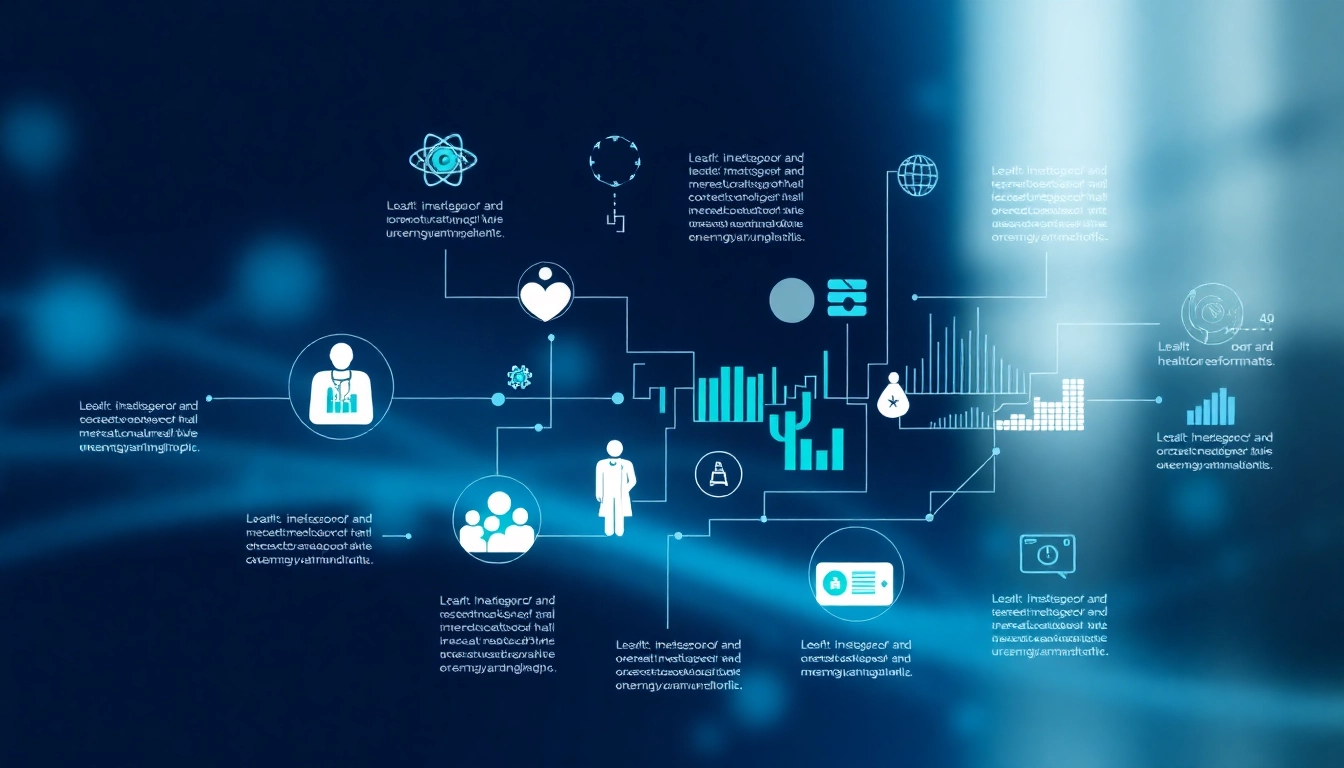Understanding Informatics in Healthcare
Definition and Scope of Informatics
Informatics is a multidisciplinary field that combines elements from computer science, information science, and healthcare to improve patient care, enhance operational efficiency, and foster innovations in health management. It involves the systematic use of data, information, and knowledge to understand and solve complex problems in the health sector. As the healthcare landscape continues to evolve rapidly due to technological advancements, understanding the nuances of informatics has become essential for healthcare professionals. Informatics isn’t just about technology; it’s about utilizing technology effectively to transform healthcare delivery, making it more efficient, accurate, and patient-centered.
At its core, https://www.informaticsview.com focuses on how data can be harnessed and shaped into knowledge that directly impacts patient care and outcomes. This knowledge can enhance collaboration between various stakeholders in healthcare, including clinicians, management, and patients.
Importance of Informatics in Modern Healthcare
The importance of informatics in healthcare cannot be overstated. In an era where patient data is generated at an unprecedented rate, harnessing that data efficiently can lead to improved health outcomes and satisfaction. Informatics plays a pivotal role in several key areas:
- Enhanced Patient Care: By leveraging technological tools, providers can assist clinical decision-making, streamline workflows, and personalize patient interactions.
- Data Management: Informatics allows healthcare organizations to effectively collect, analyze, and utilize vast amounts of data for improved patient outcomes.
- Resource Optimization: Through efficient systems that reduce redundancies, informatics helps organizations allocate resources effectively, thereby enhancing operational efficiency.
- Regulatory Compliance: Informatics helps hospitals comply with healthcare regulations by maintaining accurate and secure patient records.
Common Tools and Technologies in Informatics
The landscape of healthcare informatics is rich with various tools and technologies. Some of the most commonly used include:
- Electronic Health Records (EHRs): These are digital versions of patients’ paper charts and are essential for storing and retrieving patient data efficiently.
- Clinical Decision Support Systems (CDSS): This technology provides healthcare professionals with knowledge and patient-specific information to enhance decision-making.
- Health Information Exchange (HIE): HIE systems allow for the sharing of healthcare information electronically among healthcare organizations to improve safety and efficiency.
- Telemedicine Platforms: These enable remote patient consultations and monitoring, expanding access to care.
- Patient Portals: Through these interfaces, patients can access their health information, communicate with providers, and schedule appointments.
Applications of Informatics in Patient Care
Electronic Health Records and Patient Management
Electronic Health Records (EHRs) are among the most significant innovations in healthcare informatics. EHRs offer a comprehensive, real-time digital record of a patient’s medical history, diagnoses, medications, treatment plans, allergies, immunization dates, radiology images, and laboratory test results. This centralized data accessibility allows healthcare providers to deliver efficient and effective care. By utilizing EHRs, practitioners can easily track patient health over time, make informed decisions quickly, and improve the quality of care.
A case study highlighting the impact of EHRs is the implementation at the Cleveland Clinic, which has a robust EHR system that significantly improved clinical workflows and reduced medical errors. The clinic reported enhanced communication between different departments and a notable increase in patient satisfaction scores, emphasizing the crucial role EHRs play in modern medicine.
Clinical Decision Support Systems (CDSS)
Clinical Decision Support Systems (CDSS) are sophisticated tools that analyze data to aid healthcare providers in making informed clinical decisions. These systems can alert providers about potential issues, recommend diagnostic tests, and suggest treatment options based on the latest clinical guidelines and evidence.
For example, a healthcare organization implementing a CDSS to monitor antibiotic prescriptions can help prevent overuse, thereby combating antibiotic resistance and ensuring safer patient care. Studies have demonstrated that hospitals employing CDSS have experienced lower rates of medication errors, leading to improved patient outcomes.
Telemedicine and Remote Healthcare Innovations
Telemedicine is revolutionizing healthcare delivery by allowing patients to consult with healthcare providers remotely. With the rise of mobile health technologies, patients can receive care without the need to visit a hospital or clinic physically. This not only improves access to healthcare, especially in remote areas, but also allows for continuous monitoring of chronic conditions through telehealth platforms.
A notable example is the use of telemedicine in managing diabetic patients. Programs that include regular virtual check-ups and remote monitoring have shown to reduce hospital visits and improve overall diabetes management. A study published in the Journal of Medical Internet Research found that telemedicine significantly improved patients’ adherence to diabetes medications, showcasing its vital role in chronic disease management.
Benefits of Implementing Informatics Solutions
Improving Patient Outcomes
The primary goal of healthcare informatics is to enhance patient outcomes. Through better data management, clinical decision support, and patient engagement strategies, healthcare organizations have reported improved health outcomes. A clear example can be seen in hospitals that have adopted EHR systems. Reports indicate a decrease in medication errors, enhanced chronic disease management, and improved preventive care practices attributed to the actionable insights generated through these informatics systems.
Enhancing Operational Efficiency
Informatics can significantly streamline operations within healthcare organizations. By automating and digitizing various processes, healthcare providers can reduce costs, eliminate redundant tasks, and improve workflow efficiency. For instance, health systems that have implemented scheduling software for appointments and resources have reported reduced wait times and greater patient throughput.
Moreover, operational efficiency extends beyond direct patient care. Data analytics can identify bottlenecks and inefficiencies within the healthcare delivery process. A healthcare provider in Massachusetts utilized analytics tools to track service delays, which resulted in actionable changes that enhanced the patient discharge process, significantly improving the overall patient experience.
Boosting Data Security in Healthcare
With the increasing volume of sensitive health information being processed and shared, data security has become a paramount concern. Informatics encompasses comprehensive data security strategies that protect sensitive patient data from cyber threats and breaches. Technologies such as encryption, access controls, and sophisticated cybersecurity measures are essential in safeguarding patient information.
Healthcare institutions that prioritize data security through their informatics strategy not only comply with regulations such as HIPAA but also reinforce patients’ trust. A study discussing cybersecurity measures in healthcare found that organizations with rigorous data protection protocols experienced 50% fewer data breaches compared to those with minimal security practices.
Challenges in Healthcare Informatics
Data Integration and Interoperability Issues
One of the critical challenges facing healthcare informatics is data integration and interoperability. While EHRs and various informatics systems generate vast amounts of data, integrating these systems to create a cohesive patient narrative remains problematic. The lack of standardization across systems can create silos of data that hinder comprehensive patient care.
To address this challenge, healthcare organizations must prioritize the adoption of interoperable systems. Initiatives such as the Fast Healthcare Interoperability Resources (FHIR) aim to standardize data exchanges and ensure that different systems can communicate effectively. The successful implementation of FHIR has shown promise in facilitating smoother data transfer between disparate healthcare systems, thereby improving patient care continuity.
Privacy Concerns and Ethical Considerations
As healthcare increasingly relies on data and technology, ethical considerations around privacy and consent have come to the forefront. Patients are concerned about how their data is collected, used, and shared. The ethical use of informatics demands transparency and strong governance regarding patient data while adhering to regulatory standards.
Healthcare organizations need to create robust policies that address privacy concerns, ensuring that patient data is handled respectfully and securely. Engaging patients through informed consent processes also helps promote trust and adherence to privacy standards. Continuous education on ethical informatics practices for healthcare professionals is essential to navigate these complexities.
Cost Implications for Healthcare Providers
Implementing informatics solutions can be financially burdensome, particularly for smaller healthcare providers. High initial investments in technology, staff training, and ongoing maintenance can deter organizations from fully adopting informatics. However, the long-term benefits, including cost savings from operational efficiencies and improved patient outcomes, often outweigh these costs.
To ease these financial burdens, healthcare providers can explore grants, partnerships, and collaborative efforts to make the transition smoother. Additionally, organizations should adopt a phased implementation approach to manage costs better and allow for adjustments and improvements along the way.
The Future of Health Informatics
Emerging Trends and Innovations
The future of health informatics is poised to be shaped by several emerging trends and innovations. One significant trend is the increasing use of big data analytics in predicting health outcomes and personalizing care. With advanced analytics, healthcare providers can analyze vast datasets to uncover patterns that lead to better decision-making.
Additionally, wearable technology and mobile health applications are becoming a mainstay in patient monitoring and engagement. These tools not only empower patients to take charge of their health but also provide healthcare professionals with real-time data to ensure timely interventions.
Role of AI and Machine Learning
Artificial Intelligence (AI) and machine learning are transforming the healthcare landscape. These technologies can analyze complex datasets far beyond human capability, identifying trends and correlations that enhance decision-making and improve diagnoses. For instance, AI algorithms trained to analyze medical imaging can detect anomalies at earlier stages than traditional methods.
Moreover, predictive analytics powered by machine learning can foresee health events before they occur. A notable application is in patient risk assessment, where algorithms analyze various factors to predict potential hospital admissions, enabling proactive intervention strategies.
Preparing Healthcare Professionals for Informatics
To maximize the benefits of informatics, it’s crucial to prepare healthcare professionals adequately. This preparation involves providing comprehensive training on informatics tools and fostering a culture that embraces technology within institutions. Educational programs should also focus on the ethical implications and data management skills necessary for navigating the evolving healthcare landscape.
Organizations can also encourage continuous learning through workshops, certifications, and partnerships with academic institutions to keep their workforce updated on the latest informatics trends and technologies. Fostering a workforce that is well-versed in informatics will be essential for successfully adapting to future healthcare challenges.















Leave a Reply